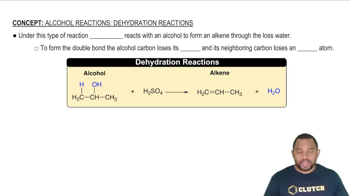Ch.22 - The Main Group Elements
Chapter 22, Problem 167
A 500.0 mL sample of an equilibrium mixture of gaseous N2O4 and NO2 at 25 °C and 753 mm Hg pressure was allowed to react with enough water to make 250.0 mL of solution at 25 °C. You may assume that all the dissolved N2O4 is converted to NO2, which disproportionates in water, yielding a solution of nitrous acid and nitric acid. Assume further that the disproportionation reaction goes to completion and that none of the nitrous acid disproportionates. The equilibrium constant Kp for the reaction N2O4(g) ⇌ 2 NO2(g) is 0.113 at 25 °C. Ka for HNO2 is 4.5 * 10^-4 at 25 °C. (a) Write a balanced equation for the disproportionation reaction. (b) What is the molar concentration of NO2-, and what is the pH of the solution? (c) What is the osmotic pressure of the solution in atmospheres? (d) How many grams of lime (CaO) would be needed to neutralize the solution?
 Verified step by step guidance
Verified step by step guidance1
Step 1: Write the balanced chemical equation for the disproportionation reaction of NO2 in water. NO2 reacts with water to form nitrous acid (HNO2) and nitric acid (HNO3). The balanced equation is: 3 NO2(g) + H2O(l) → 2 HNO3(aq) + NO(aq).
Step 2: Calculate the initial moles of N2O4 and NO2 using the ideal gas law. Use the given pressure (753 mm Hg), volume (500.0 mL), and temperature (25 °C) to find the total moles of gas. Then, use the equilibrium constant Kp to find the equilibrium concentrations of N2O4 and NO2.
Step 3: Determine the moles of NO2 that dissolve in water and undergo disproportionation. Since the reaction goes to completion, all NO2 is converted to HNO2 and HNO3. Calculate the moles of each acid formed using stoichiometry from the balanced equation.
Step 4: Calculate the molar concentration of NO2- in the solution. Use the dissociation constant (Ka) for HNO2 to find the concentration of NO2- ions in the solution. Set up an equilibrium expression for the dissociation of HNO2 and solve for the concentration of NO2-.
Step 5: Calculate the pH of the solution using the concentration of H+ ions from the dissociation of HNO2 and HNO3. Use the formula pH = -log[H+]. Then, calculate the osmotic pressure using the formula π = iMRT, where i is the van't Hoff factor, M is the molarity, R is the gas constant, and T is the temperature in Kelvin. Finally, determine the grams of lime (CaO) needed to neutralize the solution by calculating the moles of H+ and using stoichiometry with the reaction CaO + 2 H+ → Ca2+ + H2O.
Key Concepts
Here are the essential concepts you must grasp in order to answer the question correctly.
Equilibrium and Equilibrium Constants
Equilibrium in chemistry refers to the state in which the concentrations of reactants and products remain constant over time, as the forward and reverse reactions occur at the same rate. The equilibrium constant (Kp) quantifies the ratio of the concentrations of products to reactants at equilibrium for a given reaction at a specific temperature. Understanding Kp is essential for predicting how changes in conditions affect the position of equilibrium.
Recommended video:
Guided course

Equilibrium Constant K
Disproportionation Reactions
A disproportionation reaction is a specific type of redox reaction where a single substance is simultaneously oxidized and reduced, resulting in two different products. In this context, the disproportionation of NO2 in water leads to the formation of nitrous acid (HNO2) and nitric acid (HNO3). Recognizing the products of this reaction is crucial for calculating concentrations and pH in the solution.
Recommended video:
Guided course

Alcohol Reactions: Dehydration Reactions
Osmotic Pressure
Osmotic pressure is the pressure required to prevent the flow of solvent into a solution through a semipermeable membrane, and it is directly related to the concentration of solute particles in the solution. The formula for calculating osmotic pressure (π) is π = iCRT, where 'i' is the van 't Hoff factor, 'C' is the molar concentration, 'R' is the ideal gas constant, and 'T' is the temperature in Kelvin. Understanding this concept is vital for determining the osmotic pressure of the solution formed after the reaction.
Recommended video:
Guided course

Osmotic Pressure Formula
Related Practice
